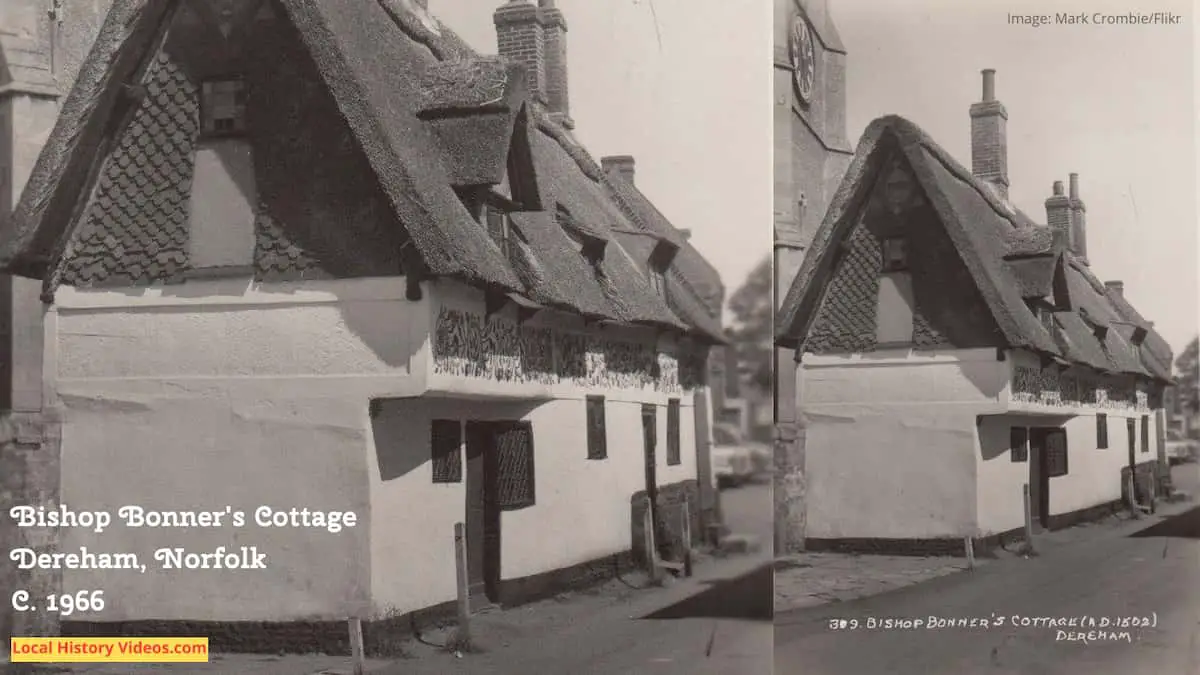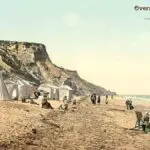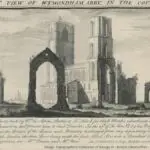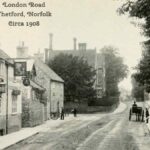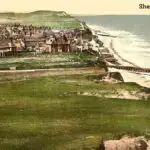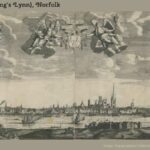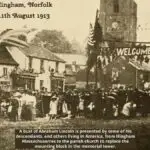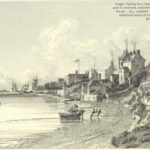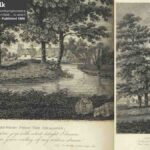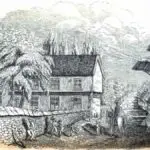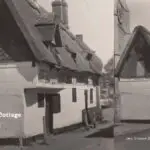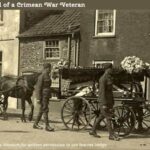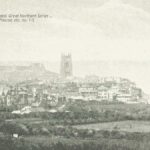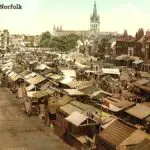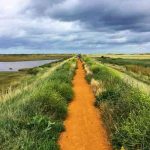Glimpse history through old images of Dereham, Norfolk, England, also known as East Dereham.
Aviation Lessons (1966)
Margaret Rushworth and Barry Smith were two of the sixth formers being taught aviation by Dick Smith and Taffy Rich at Dereham High School in 1966. The lessons included accompanied flights on a Tiger Moth, before moving on to a solo flight and a girocopter.
Sixth Form Flies High (1966) – British Pathé on YouTube
A bit of Dereham history
Extract: Kelly’s Directory of Cambridgeshire, Norfolk and Suffolk
Published in 1883
Page 286
EAST DEREHAM is a thriving market town, railway station and parish, head of a county court district and polling place for the Southern division of the county, in the hundred of Mitford, union of Mitford and Launditch, rural deanery of Hingham, archdeaconry of Norfolk and diocese of Norwich, 127 miles from London by rail and 100 by road, 16 west – by – north from Norwich, 124 east – by – north from Swaffham, 11 north – west from Wymondham and 25 east from Lynn: it is a junction – station of the Lynn branch of the Great Eastern railway, and has communication to all parts of the kingdom.
The town is well drained with new sewerage works, and lighted with gas, and is governed by a Local Board of 12 members: the Headboroughs are the trustees of the assembly rooms and other property, and after paying certain outgoings, the balance, about £ 100 is paid over to the Local Board in reduction of the rates.
Waterworks were erected in 1881, to supply the town, from deep wells, at a cost of £ 4,000; a fire brigade was formed in 1879, and has two engines with all the apparatus by Merryweather, of London.
The place is very ancient, and is supposed to have been made a parish by Anna, who was King of the East Angles from 635 to 654; his daughter Withharga founded a nunnery here; the Saxon Chronicle records that fifty – five years after her death her body was found all whole and uncorrupted as on the day of her internment, and was removed into the church; subsequent writers add that from her burial – place in the churchyard issued forth a spring of the purest water, gifted with many healing virtues.
The sisterhood were driven out of their cell about the year 870, when the country was overrun by the Danes.
The tomb of Withburga having become of great repute for the cure of diseases, the Abbot of Ely became very desirous of getting possession of her body, in order to translate it to Ely: he concerted a scheme for stealing it, which he carried into effect the night after a feast which the Abbot, as lord of the town, gave at his court – leet: this exploit, called in the history, ” a sanctified sacrilege, a pious theft, a soul – saving robbery, ” was perpetrated on the 8th of July, 974.
In the reign of Queen Elizabeth a fire happened, on the 1st of July, 1581, by which the whole town was destroyed; a second fire occurred on the 3rd of July, 1670, during the reign of Charles II. by which 170 houses were burnt, and property destroyed to the value of £ 19,500.
The church of St. Nicholas is an ancient stone building, erected on the site of the conventual chapel: it consists of chancel, nave, aisles and transepts with eastern chapels ( dedicated to St. Thomas of Canterbury and St. Withburga ) and a central lantern tower: the bell – tower which is square and detached from the church, was commenced about 1508 and contains a peal of 8 hells: the styles of architecture. are various, the church having been erected and altered at different periods: there are vestiges of the Norman in portions of two twisted shafts on the west side of the jambs of the chancel arch; the chancel itself is Early English, built about 1250, but the tracery of the east window is of much later insertion, as well as the chancel arch; the west door with an ogee headed niche on each side, the great window over it, and the whole of the north aisle, except the doorway, are in the Decorated style; the lantern tower standing on four fine arches, with triforium arcade and clerestory, the transepts, eastern chapels, the arches of the nave and the westernmost piers are Perpendicular: there is a beautiful font, erected in 1468, adorned with carvings of stone, representing the seven Roman Catholic sacraments and the Apostles, but the figures were mutilated at the time of the Reformation.
There is an ancient carved muniment chest, brass eagle and organ, which has been greatly enlarged and renewed; several brasses were formerly in the church, two only of which remain in a perfect state.
Cowper, the poet, is buried in the church ( 1800 ) and there are monuments to him and his relatives, Mrs. Unwin and Miss Perowne: much has been done to beautify and preserve this venerable building: many coats of whitewash were carefully removed from the stone pillars, the entire church re – seated and repaired, the east and other windows adorned with stained glass and a reredos of carved stone, beautifully illuminated, has been added: the Sacrarium is enclosed by an oak railing, with iron standards: the pulpit was made from an ancient beam of oak, almost as hard as iron, taken from the old Vicarage house at Besthorpe; it bore an inscription, which proved it to be more than three centuries old.
In the churchyard is the spring said to issue from the spot where the bones of St. Withburga were first deposited and the ancient arch, from which the water issues, is supposed to be the remains of her tomb, but the greater probability is that this erection was in very ancient times a baptistery.
The register dates from the year 1679.
About £ 1,000 has been expended on the chancel by the Ecclesiastical Commissioners, on the reversion to them of the great tithes, at the decease of the last sinecure rector.
The living is a vicarage, with the vicarage of Hoe annexed, joint yearly value £ 536 13s. 10d. with about 60 acres of vicarial glebe and house, in the gift of the Crown and held since 1850 by the Rev. Benjamin John Armstrong M.A. of Caius College, Cambridge.
A mission church in connection with the parish church was built in 1880 in the Upper Norwich road.
The Cowper ” Congregational church, erected in the year 1874, in the Gothic style, stands in the Market place, and occupies the site of the house where the poet Cowper spent his last days: the front is fared with Kentish ragstone with Bath stone dressings: it consists of apse, nave and aisles: the windows of the apse are stained and a beautiful window, representing the Good Samaritan, has been inserted at the west end: there is a carved stone pulpit: the reading desk and communion table are of oak, and the wood work of the bed – room in which Cowper died has been preserved and fitted in the minister’s vestry: Mr. Edward Boar – fman, of Norwich, was the architect of the building, the total cost of which, including lighting apparatus, was about £ 3,500.
In front of the church is a memorial of Cowper, in polished granite, which bears the following inscription, written by the late Dean Stanley: ” This monumentis erected on the site of the house where the beloved poet of Olney, William Cowper, spent the last years of his life, under the care of faithful friends. He lies buried in the parish church, having here given up his soul to God, April 25th, 1800. ” Then follow a few lines from ” The Task. ”
The Baptist chapel, High street, was built in 1793, The Primitive Methodist chapel, Commercial road, was built in 1863.
The Trinity Wesleyan church, situated in Theatre street, is a Gothic building of Kentish rag with Bath stone dressings built in 1880, at a cost of £ 3,500, including the erection of the Sunday schools and the minister’s residence, erected on the site of the old one, the architect being Mr. Edward Boardman of Norwich; the fittings throughout are of pitch pine, and the building is heated by hot water.
The Cemetery was opened in 1809: it is about 5 acres in extent and contains two mortuary chapels; it is under the control of a Burial Board of 9 members.
The charities amount to about £ 400 yearly, for distribution, and there are 84 acres of fuel allotment.
The Coro Hall, erected in 1856, at a cost of more than £ 3,000, is a handsome building, in the Market place, and affords great facilities to merchants and farmers transacting business here.
The Assembly Rooms, built in 1756, on the site of the old market cross, form a spacious brick building, in which the magistrates hold petty sessions for the hundred every alternate Friday there is a leading Room and Institute in the same building.
The manufactures of the town are principally connected with agriculture: there are manufactories of agricultural steam engines and threshing and other machines and iron foundries; coach works, saw mills, breweries, maltings, and shoe factory, and there are many handsome modern shops.
The market is held on Friday, and is well supplied with corn, live stock and provisions of every description.
The situation of the town, in the centre of a fertile and highly cultivated district, and its distance from any other market of any consequence, cause Dereham to rank among the best markets of the county.
Fairs are held in the Market place on the Thursday before July 6th and September 29th.
There are four branch banks.
A company of rifle volunteers was embodied in 1860, of which H. E. Hyde esq. is captain.
Quebec House, the seat of Col. William Earle Gascoyne Lytton Bulwer J.P. High Sheriff for Norfolk, 1883, situate a mile north – west from the town, is Gothic, and derives its name from having been built at the time of the capture of Quebec; it stands in an extensive lawn, which is well timbered, and is partly surrounded by plantations.
The area of the parish of East Dereham is 5,222 acres; rateable value, £ 27,013; and the population of the parish in 1861 was 4,368, in 1871 was 5,107, and in 1881 was 5,040, and of the town about 4,000.
DILLINGTON, in Launditch hundred, is a hamlet in this parish, one mile north – east. DUMPLING GREEN, 2 miles south – east; ETLING GREEN, 16 mile north – east; NORTH HALL GREEN, 1 mile north; SOUTH GREEN, half a mile, and TopTWOOD, 1 mile south, are other hamlets.
Parish Clerk, George Philo.
More about Norfolk
- Old Images of Norfolk, England
- Old Images of Wymondham, Norfolk
- Old Images of Thetford, Norfolk
- Old Images of Sheringham, Norfolk
- Old Images of King’s Lynn, Norfolk
- Old Images of Hunstanton, Norfolk
- Old Images of Hingham, Norfolk
- Old Images of Gorleston-on-Sea, Norfolk
- Old Images of Fakenham, Norfolk
- Old Images of Diss, Norfolk
- Old Images of Dereham, Norfolk
- Old Images of Overstrand, Norfolk
- Old Images of Attleborough, Norfolk
- Old Images of Holt in Norfolk
- Old Images of Cromer, Norfolk
- Old Images of Norwich, Norfolk
- Old Images of Great Yarmouth, Norfolk
- Norfolk: Local History Resources

